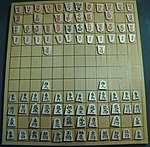
| Shogi variants |
|---|
 |
| Standard shōgi (9×9, drops) |
| Small variants |
|
| Standard-size variants |
|
| Large variants |
|
| Multiplayer variants |
|
| 3D variants |
|
| Miscellaneous variants |
|
Taikyoku shōgi (Japanese: 大局将棋, lit. "ultimate shogi") is the largest known variant of shogi (Japanese chess). The game was created around the mid-16th century (presumably by priests) and is based on earlier large board shogi games. Before the rediscovery of taikyoku shogi in 1997, tai shogi was believed to be the largest physically playable chess variant ever. It has not been shown that taikyoku shogi was ever widely played. There are only two sets of restored taikyoku shogi pieces and one of them is held at Osaka University of Commerce.[1] One game may be played over several long sessions and require each player to make over a thousand moves.
Because the game was found only recently after centuries of obscurity, it is difficult to say exactly what all the rules were. Several documents describing the game have been found; however, there are differences between them. It is not too clear how accurate the rules given by modern sources for the game are, because many of the pieces appear in other shogi variants with a consistent move there, but are given different moves in taikyoku shogi. The board, and likewise the pieces, were made much smaller than usual for the other variants, making archeological finds difficult to decipher. Research into this game continues.
- ^ Osaka University of Commerce: Amusement Industry Labo. "過去の展示情報 (Past exhibition information)". Retrieved 18 January 2013.